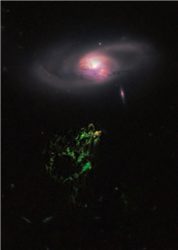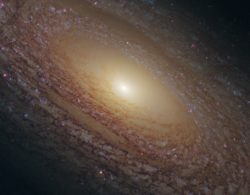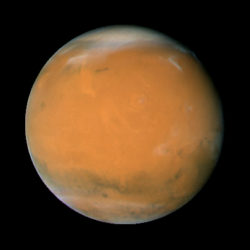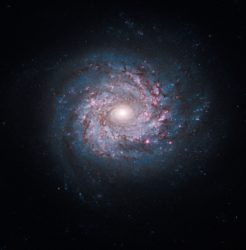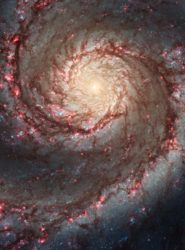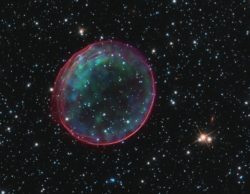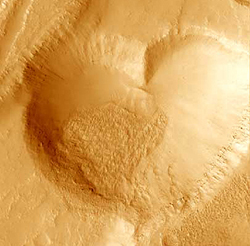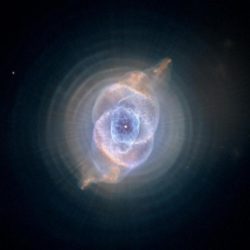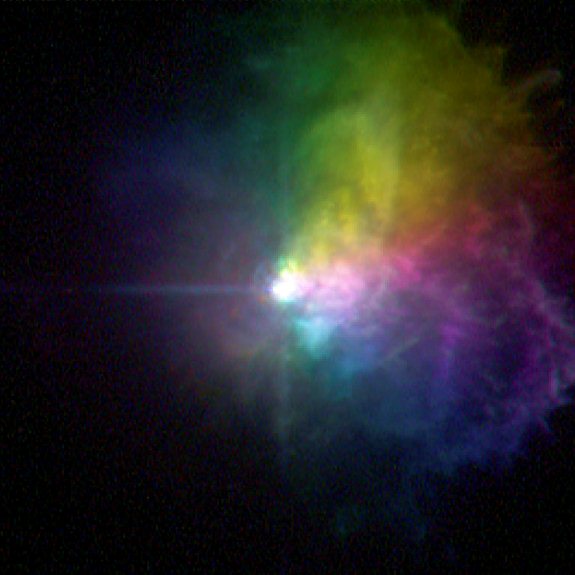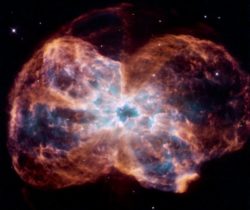Astronomy Picture of the Week – NGC 6782
This spiral galaxy is called NGC 6782. When seen in visible light, it exhibits tightly wound spiral arms that give it a pinwheel shape similar to that of many other spirals. However, when viewed in ultraviolet light with NASA's Hubble Space Telescope, its shape is startlingly different.
Astronomy Picture of the Week – Space Oddity
This unusual ghostly green blob of gas appears to float near a normal-looking spiral galaxy in the image taken by NASA's Hubble Space Telescope. The bizarre object, dubbed Hanny's Voorwerp (Hanny's Object in Dutch), is the only visible part of a 300,000-light-year-long streamer of gas stretching around the IC 2497 galaxy.
Astronomy Picture of the Week – Spiral Galaxy NGC 2841
This view of the majestic disk of stars and dust lanes of the spiral galaxy NGC 2841 was taken by NASA’s Hubble Space Telescope in 2010. The galaxy lies 46 million light-years away in the constellation of Ursa Major. Credit: NASA, ESA, and the Hubble Heritage (STScI/AURA)-ESA/Hubble Collaboration Acknowledgments: M. Crockett and S. Kaviraj (Oxford University, UK), R. O’Connell (University of Virginia), B. Whitmore (STScI), and the WFC3 Scientific Oversight Committee
Astronomy Picture of the Week – Mars as seen by Hubble
This is one of the best photos of Mars ever taken from Earth or Low Earth Orbit. NASA's Hubble Space Telescope took this close-up of the red planet Mars when it was just 88 million kilometers away. This color image was assembled from a series of exposures taken within 36 hours of the Mars closest approach…
Astronomy Picture of the Week – Spiral Galaxy NGC 3982
This spiral galaxy, called NGC 3982, looks similar to our own galaxy but it is much smaller. NGC 3982 spans about 30,000 light-years which makes it roughly one-third of the size of the Milky Way galaxy. It is located about 68 million light-years away in the constellation Ursa Major. This image is composed of pictures taken by the Hubble Space Telescope’s Wide Field Planetary Camera 2 (WFPC2), the Advanced Camera for Surveys (ACS), and the Wide Field Camera 3 (WFC3) between March 2000 and August 2009. Image Credit: NASA, ESA, and the Hubble Heritage Team (STScI/AURA)
Astronomy Picture of the Week – Whirlpool Galaxy
This image of the spiral galaxy M51, dubbed the Whirlpool Galaxy, was taken by NASA’s Hubble Space Telescope. M51 is a typical spiral galaxy which includes graceful, curving arms, pink star-forming regions, and brilliant blue strands of star clusters. It is located at a distance of approximately 31 million light-years from the Milky Way Galaxy in the constellation Canes Venatici. It is one of the most famous galaxies in the sky. M51 can easily be observed by amateur astronomers, and may even be seen with binoculars. Image Credit: NASA, ESA, S. Beckwith (STScI), and the Hubble Heritage Team (STScI/AURA)
Astronomy Picture of the Week – Supernova Bubble Resembling Holiday Ornament
This image was made by combining data from two of NASA's Great Observatories: the Hubble Space Telescope and the Chandra X-ray Observatory. The supernova remnant, cataloged as SNR 0509-67.5, is the result of a type Ia supernova. It is located in the Large Magellanic Cloud (LMC), a small galaxy about 160,000 light-years from Earth.
Cosmic Hearts
I hope you all had a happy Valentine's Day! :) Here are some pictures of cosmic hearts: A heart-shaped crater on Mars captured by the Mars Orbiter Camera onboard the Mars Global Surveyor. A heart-shaped Nebula, called W5, located 6000 light years away in the constellation of Cassiopeia.
Astronomy Picture of the Week – The Cat’s Eye Nebula
This detailed view of the so-called Cat’s Eye Nebula was taken by NASA’s Hubble Space Telescope. The nebula, formally cataloged as NGC 6543, was one of the first planetary nebulae to be discovered and is one of the most complex. Observations suggest the star ejected its mass in a series of pulses at 1,500-year intervals. This created dust shells, each of which contain as much mass as all of the planets in our solar system combined. These concentric shells make a layered, onion-skin structure around the dying star. Image Credit: NASA, ESA, HEIC, and The Hubble Heritage Team (STScI/AURA)
Astronomy Picture of the Week – Polarized Star Light
This picture taken by the Hubble Space Telescope shows the polarized light of the massive star VY Canis Majoris. Image Credit: NASA, ESA, and R. Humphreys (University of Minnesota)
Astronomy Picture of the Week – Interacting Spiral Galaxies NGC 2207 and IC 2163
This near-collision has been caught in a photo by NASA's Hubble Space Telescope. Two spiral galaxies pass by each other like majestic ships in the night. They are located in the direction of the constellation Canis Major.
Astronomy Picture of the Week – The Colorful Demise of a Sun-Like Star
This image, taken by the Hubble Space Telescope, shows the colorful demise of a Sun-like star. The star is ending its life by casting off its outer layers of gas, which formed a cocoon around the star’s remaining core. Ultraviolet light from the dying star makes the material glow. The burned-out star, called a white dwarf, is the white dot in the center. It is one of the hottest known white dwarfs, with a surface temperature of nearly 200,000 degrees Celsius. The nebula is called NGC 2440 and lies about 4,000 light-years from Earth in the direction of the constellation Puppis. Image credit: NASA, ESA, and K. Noll (STScI)


